35 Free SWOT Analysis Templates For Word, Excel, Google Docs, Powerpoint, and PDF
Last Updated on April 1, 2022 by Owen McGab Enaohwo
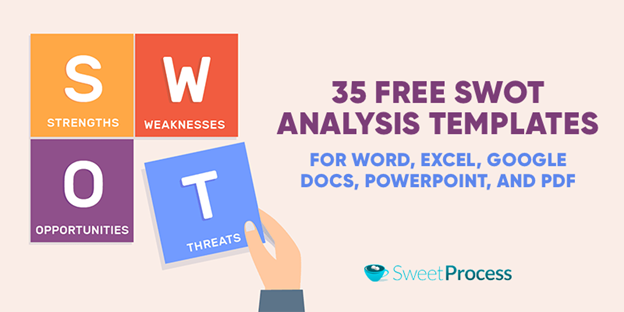
If you run a business, you understand how difficult it is to stand out in any niche. More than ever before, your competitors have access to the same information as you do. They’re affected by the same policies of the government and other regulatory bodies. They know who your top employees are and can even poach them to join their team instead.
So, what can you do to grow your business despite the stiff competition?
Simple. Start by conducting a SWOT analysis for your business.
A SWOT analysis helps you to identify the what, why, and how of your business activities and how to leverage them to achieve your business goals.
It also helps you to simplify the intended objectives of any project and identify the internal and external factors that are favorable and unfavorable to achieving those objectives.
That way, you can connect the actions of today to what will happen in the future. Not only that, it helps you to identify the frameworks and strategies you can use to consistently and efficiently achieve extraordinary progress that can stand the test of time.
In this post, you’ll learn everything you must know about SWOT analysis. We’ll also give you access to more than 35 free editable and downloadable SWOT analysis templates for Word, Excel, Google Docs, Powerpoint, and PDF.
Let’s get started.
Chapter One: What Does SWOT Analysis Mean?
Chapter Two: How to Write a SWOT Analysis
Chapter Three: SWOT Analysis Examples, Best Practices, and Design Tips
Chapter Four: SWOT Analysis Templates For Word
Chapter Five: SWOT Analysis Templates For Excel
Chapter Six: SWOT Analysis Templates For Google Docs
Chapter Seven: SWOT Analysis Templates For Powerpoint
Chapter Eight: SWOT Analysis Templates for PDF
Chapter Nine: SWOT Analysis Templates Frequently Asked Questions (FAQs)
Chapter Ten: Manage Your SWOT Analysis Templates Effectively Using SweetProcess
Chapter One: What Does SWOT Analysis Mean?
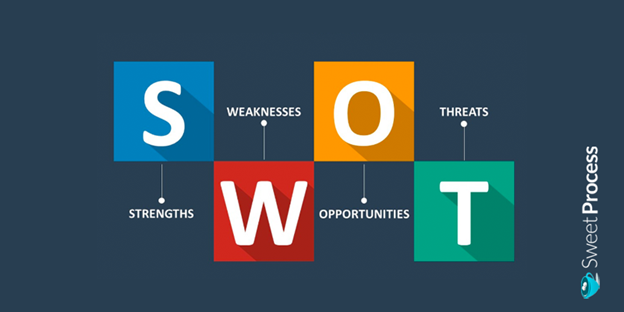
SWOT is an acronym for strengths, weaknesses, opportunities, and threats. It is a four-step framework for conducting an analytical evaluation of any business.
SWOT is one of the most important tools for a business assessment. It helps businesses break down what is best at every moment and how to execute tasks successfully. It also allows you to identify what you can’t do so you find a way of closing those loose ends.
Aside from managing the business operations, you can use a SWOT analysis to examine the strategic and operational weight of your company’s human capacity. That way you can plan, strategize, and execute personal projects effectively while focusing on what works better than others.
What is a SWOT Analysis?
A SWOT analysis explains the structured idea or framework used to assess a company’s strategic planning and competitive position. It breaks down the internal and external factors as well as the current and future potential of any business entity.
It is structured to bring about a realistic, fact-based, and data-driven gaze at the strengths and weaknesses of any business, organization, or individual.
What Does SWOT Stand For?
SWOT is an acronym that stands for strengths, weaknesses, opportunities, and threats.
It is a framework that businesses use to:
- Identify what makes them unique compared to competitors
- Analyze areas where their competitors perform much better than them
- Discover short-, medium-, and long-term opportunities they can leverage to grow their business
- Highlight the external challenges that the business could face in the long run
Now let’s explain what each word in SWOT means in detail.
- Strengths
A business is said to have strength if it has an internal factor that gives it a competitive edge. This could be your team members, intellectual properties, location, and anything that contributes to the success of your business.
It could also include your skills and capabilities, resources in your possession, and your brand’s reputation.
- Weaknesses
This is also classified as an internal factor and seen as a lag embedded in your business. Identifying your weaknesses can improve your business.
Here are ways to identify your weakness:
- Who are your competitors?
- What are they doing better?
- What part of the business can you improve?
- What generates the most customer complaints?
Opportunities
Opportunities are external factors that you should take advantage of to make profits, adhere to compliance, and become innovative. The knowledge of the internal factors could help in forming an opinion about the opportunities in your business environment.
To properly examine this, you have to know the following:
- Where to apply your strength?
- How are your customers and their needs changing?
- How does technology affect your business?
- What are some new ways to produce your products?
Threats
Threats are external factors that you cannot control that negatively impact your business. Identifying them quickly can be advantageous in many ways. Avoiding them will allow your business to stand the test of time.
To identify your business threats, you should ask questions like:
- What are your competitors developing?
- Are customers able to meet their needs with alternative products?
- Are your rivals improving their product offerings or prices?
- Is new technology making your product obsolete?
- Are your employees happy?
- Is turnover high?
- Are sales growing slower than the industry average or not?
Why Use a SWOT Analysis?
Businesses that do not know their market positioning won’t compete favorably in their industry. This is why the SWOT analysis is an integral part of any business that wants to succeed.
The framework will help you to identify and understand the key issues that affect your business and how to find solutions to them.
With a SWOT analysis, you know where your business strengths lie, what the weaknesses are, the opportunities you can take advantage of, and the threats that could impact your business negatively.
Who Can Use a SWOT Analysis?
The SWOT analysis framework can be used by new businesses and individuals across major industries to monitor internal and external factors that could affect their personal or business goals. Existing businesses can weigh all their current situations and come up with a strategy to move forward using this framework as well.
Chapter Two: How to Write a SWOT Analysis

With the SWOT analysis, businesses are able to come up with plans to amplify their voices and succeed in any competitive niche.
Here’s a step-by-step guide for writing a SWOT analysis.
Components of a SWOT Analysis
Below are the major components of a SWOT analysis.
- Strengths
These are what you possess as an organization that your competitors don’t. Examples include: quality of service, location of your business, innovative products, employees’ attitude, etc.
- Weaknesses
These are things that you should improve on as an organization which you’re currently lacking. Examples include business processes, brand building, customer satisfaction, etc.
- Opportunities
These are chances that your company can exploit which could be a game-changer for your business. Examples include: fresh supply of resources, change in your customers’ lifestyles, new market pathway, etc.
- Threats
These are external factors that could affect your business which you have little to no control over. Examples include: change in policy by regulators, new technology, cash-flow problems, etc.
The only solution to this is to work on areas where the challenges are inherent and make it better, or develop strategies to minimize the impacts of such industry changes and also develop techniques against competing forces.
Examples could be a change in customer behavior, market declination, and product innovation.
Internal and External Factors in a SWOT Analysis
The internal factors in a SWOT analysis are strengths and weaknesses while the external factors are opportunities and threats.
The internal factors include the resources and capabilities within a business. You are absolutely in control of these factors. Your business can design strategies and objectives to improve and leverage your strengths and reduce weaknesses. Examples are your company’s human resources, products, technical capabilities, and financial resources.
The external factors are activities that your business doesn’t have control over. These are the opportunities and threats. Although your business can forecast to take advantage of opportunities when they come, you can never know the threats coming your way; you can only put some measures in place to conquer them. These could include technological innovations, competitions, economic trends, government policies, and social trends.
How to Conduct a SWOT Analysis
When conducting a SWOT analysis, here are the steps to follow:
- Decide the objective of the SWOT analysis
You must have an idea of the objective of the SWOT analysis before conducting it. It could be as little as knowing the type of product and manufacturing process you want to analyze, or the staff in question.
- Understand the business, industry, and market
Understanding your business, industry, and how the market works will allow you to improve your value chain. As you conduct the SWOT analysis, your staff, business partners, and clients are some of the parameters to put in perspective for better clarity.
- Highlight your business strengths
Create a list of what your business can do and the advantages it has over others in your space. This will inform the decision-making as you’ve carefully stated your strengths, and it will help your business.
Examples of your business strengths could be your location, employees, finances, costs, pricing advantage, and services rendered.
- Identify your business weaknesses
Being aware of your business weaknesses is useful as it helps you to visualize areas that need improvement, and you can clearly see a way out by asking for help. This part of the SWOT analysis shows you how your business will grow over time, and issues you might have in the future. This may include the absence of new products, specific staff issues, declining market share, etc.
- List the opportunities you have
Think about potential opportunities in your business and make a list of them. Note that these are not the same as your internal strengths and are not definite. You could, however, bank on opportunities that may include new technologies, diverse markets, government policies, training programs, etc.
- Have a list of threats to your business
Gather external factors that are threats to your business, put your compliance document in check, and work with them to your advantage. Other threats could include rising unemployment, competition, and higher rates.
- Create a priority list from the SWOT
After completing the last step, separate each list into quadrants. Place them side by side with each other to have an idea flow of how your business is running and the issues to address. This way you’re able to coherently organize your strengths, weaknesses, and external leverages so your brain will quickly think through how to overcome the challenges.
What to Do With Your SWOT Analysis Results
Now that you’ve conducted your SWOT analysis, the next thing is to identify strategic alternatives for your business, prioritize the alternatives, balance them, then build an implementable roadmap to walk through.
The results obtained will serve as an assessment for your current business position, and provide a pointer for your growth.
Being able to identify threats and create a safety adaptation framework is important for your company so that when a hitting policy comes, your business is ready to absorb the shock.
Chapter Three: SWOT Analysis Examples, Best Practices, and Design Tips
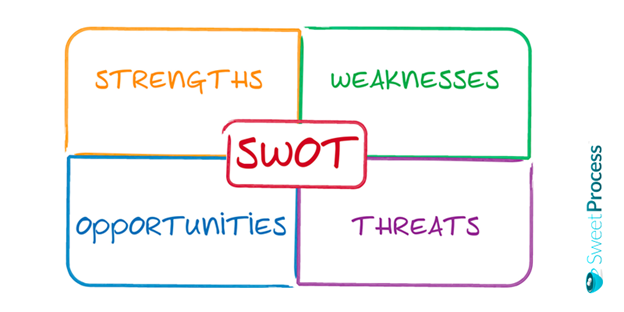
There are various types of SWOT analysis. They offer industry specifics and different styles with similarities.
Let’s say there is a restaurant in Michigan Upper Peninsula, which offers a specialty in meat pie. The company plans to open in a new location and focus on developing its business model to allow for expansion.
Immediately, the restaurant decided to conduct a SWOT analysis to determine if they need the expansion and to confirm if they have the resources to accomplish it. They came up with this SWOT analysis:
Strengths
- Location: Our location will draw in visitors and downtown shoppers.
- Uniqueness: We stand out as a unique alternative to fast food and we offer consistently high-quality snacks in a distinctive environment.
- Strong management: We have assembled a team that embraces different disciplines with expertise in all areas of the business.
Weaknesses
- Lack of capital: All startup funds will come from loans and investors.
- Lack of reputation: We haven’t yet established ourselves as a reputable groceries provider.
Opportunities
- Area growth: The new location is growing at 8.5% annually.
- Working families with children: This is a growing population, both in numbers and choices of convenient food.
Threats
- Competition: A competitor sells similar snacks and has loyal customers as well as relationships with businesses that regularly buys from them.
- Being unprepared for opening numbers: Poor service or product quality could discourage customers from returning.
Here’s another example.
Premier plastics recycles plastic waste into commercially viable products using environmentally friendly methods.
The company wants to capitalize on one of the recycling industry’s highest-growth products—polyethylene terephthalate (PET), which is found in post-consumer beverage and water bottles.
The recycled materials from the PET plant will then be channeled into a brand, Replay Plastic Packaging Division, which will produce extruded sheet plastic to sell to manufacturers.
That’s the plan, but before they begin, the owners decided to conduct a SWOT analysis. Here’s what they found:
Strengths
- Experiences: The execs of the company have experience with plastics, engineering, and building successful startups.
- Relationships: The company has excellent relationships with firms that collect and distribute PET bottles.
- Location: There is no other PET recycler in that area. Suppliers have indicated an interest in working with local recyclers.
Weaknesses
- High startup cost: The cost of opening a PET plant will require investments and loans.
- Construction time: The recycling and extrusion facility must be built before plastic processing.
Opportunities
R&D: Potential for other uses of PET recycling by-products.
Threats
- Environmental protection standard: Whenever the government regulations are updated, there is a need to develop technical and economically feasible recycling solutions that meet the standards.
- Material scarcity: the business model is PET-dependent. If the use of PET bottles declines or becomes obsolete, there won’t be any supply.
With the SWOT analysis, companies will be able to chart a profitable path and identify what problems they are likely to have before the problem comes.
SWOT Analysis Best Practices
Before developing a SWOT analysis, here are some best practices to consider.
- Have a strong knowledge of the strengths
Create a brainstorming section to know where your strengths lie. Add as many points as possible to this grid because it will be refined later as the business progresses.
With the knowledge of your business, you will be able to use the strength to think of the touchpoints, customer journey, and sales messaging to use afterward.
- Pay attention to your weaknesses
Now that you have identified your strengths, it’s time to concentrate on your business flaws.
At this stage, you should examine the resources, business and staff competencies, and also your total market offerings.
Areas of weaknesses are delivery quality, location, product lifecycle, skill sets, etc.
- Examine the internal analysis
With the knowledge of both strengths and weaknesses, you are now aware of your internal operations. At this stage, you can take a step back and compare the two lists to see if anything is missing, or you have a clearer picture of the internal operations in your business.
- Seek out opportunities
It is critical to understand the market you operate in for this idea to be effective. During the strategy session, make sure your strengths list is accessible because you will be referring to it to understand your business possibilities.
For example, your opportunity lists could include market consolidation, international expansion, new transport or delivery options, etc.
- Recognize the dangers
Threats are out of your control; therefore anticipating and managing them is crucial.
You will also be able to have a level of preparation for the worst-case scenarios so when they come, you are in a better position to manage them.
Examples of threats are competition, new technology, policy changes, and economic climates.
SWOT Analysis Design Tips
The design of your SWOT analysis is often presented in a grid-like matrix with four unique quadrants, each one representing an element (strength, weaknesses, opportunities, and threats).
The presentation offers different elements which are the internal elements versus the external ones. They display a wide range of readable and understandable situational analyses in a visual format.
With this table, businesses can display the SWOT analysis easily. Also, with the grid system (which helps with clarity), instead of having them on a long list, it is easier to compare each element accordingly as their definitions will be opposite each other.
For example, strengths are placed above opportunities which is a pointer to identify any strengths that your business could possess that can be turned into opportunities.
Also, your business threats are below your weakness, which could mean that, if there is any correlation between the two, which is your weakness that could turn to threats, you can quickly work on it and turn it to your advantage.
In the next chapter, we’ll walk through the different SWOT analysis templates by formats.
Chapter Four: SWOT Analysis Templates For Word
Microsoft Word is one of the most popular tools for making a SWOT analysis template.
Here are some free SWOT analysis templates for Word, which you can download, tweak, and use for your organization.
- Team SWOT Analysis Template

Click here to download the SWOT Analysis Template
The team SWOT analysis template is used to evaluate the strength, weaknesses, opportunities, and threats that are peculiar to the team. This explains what the team can effortlessly do, and what they are likely to struggle with. It also shows the unplanned favor and challenges that will face the team.
- Business Plan SWOT Analysis Template

Click here to download the SWOT Analysis Template
The business plan SWOT analysis template analyzes your business plan and spots the strengths and weaknesses that it has.
For instance, your business strength may be that, as the founder, you have strong accounting skills. This means that you can do your bookkeeping and manage your expenses without anyone poking a nose into it.
However, your weakness could be that you juggle too many tasks at a time, and this causes you to perform jobs of lesser quality. Your business threats could be that your raw materials supplier does late supply all the time.
When you understand these key points, you can manage your business effectively.
- Product SWOT Analysis Template

Click here to download the SWOT Analysis Template
This product SWOT analysis template lets you explain the customer pains that your product will solve and the aspirations that it will help them achieve. It will also reveal some of the lapses that the product will have. This will help you in communicating the offer and understand how other products in the market might either make or mar your success.
- Basic SWOT Analysis Template

Click here to download the SWOT Analysis Template
The basic SWOT analysis template is a simple evaluations model that anyone or any business can adopt to conduct their SWOT analysis. It has the quadrant pre-prepared for you to fit in the qualities of your strength, weaknesses, opportunities, and threats.
This template saves you the stress of having to think about how to create your SWOT analysis instead of focusing on the core characteristics that you want to fill into it.
- Hotel SWOT Analysis Template
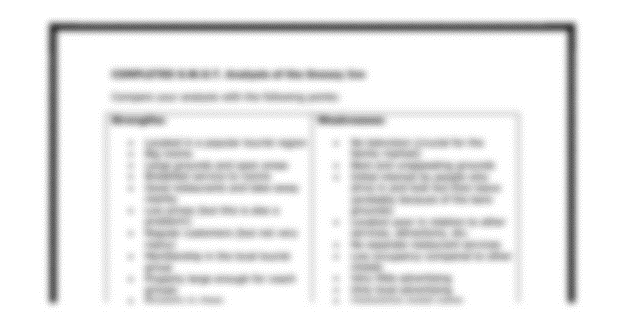
Click here to download the SWOT Analysis Template
The hotel SWOT analysis template helps you to analyze the strengths, weaknesses, opportunities, and threats of your hotel. If your hotel has well-furnished rooms and ambiance, that could be an excellent strength. However, if some part of the building is deteriorating, or the painting is gradually wearing off, that’s a weakness that could easily put the customer off.
Also, the area it is located can determine the opportunities and threats. Obviously, a hotel in an unsecured area is a threat to the customers, the hotel staff, and customers.
Chapter Five: SWOT Analysis Templates For Excel
Excel is an intuitive tool for creating a SWOT analysis template. We’ve compiled some free SWOT analysis templates for Excel below, which you can download, tweak, and use for your organization.
- Blank SWOT Analysis Template

Click here to download the SWOT Analysis Template
The blank SWOT analysis template provides you with guidance and hints on what to provide in individual boxes, and how to think through and connect the boxes.
Having this handy saves you time and the thought process when you create a SWOT analysis to improve your business process or employees.
- Marketing SWOT Analysis Template

Click here to download the SWOT Analysis Template
The marketing SWOT analysis template guides the marketing team of a company on how to position their brand and product for success. It has a section that categorizes products or services based on critical themes like capability, functionality, and quality. These help you with communicating with customers and positioning.
Chapter Six: SWOT Analysis Templates For Google Docs
Google Docs helps you create SWOT analysis templates for your business from scratch. Here are some editable and downloadable SWOT analysis templates for Google Docs which you can download, tweak, and use for your organization.
- HR SWOT Analysis Template

Click here to download the SWOT Analysis Template
The HR SWOT analysis template is used by HR professionals to evaluate the human capacity of an organization. They study various departments in that organization and identify what makes them valuable in terms of human resources.
Then, individually, they analyze the strengths, weaknesses, opportunities, and threats each of the roles and individuals in each department have.
- Employee SWOT Analysis Template
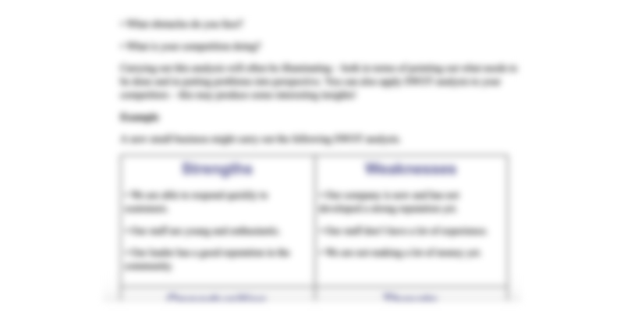
Click here to download the SWOT Analysis Template
The employee SWOT analysis template allows employees to measure their value in a department and company. This helps them analyze their skills and competencies in relation to the returns that the department gets.
This could be done through a healthy comparison of the staff to other colleagues in the department or organization.
- Simple SWOT Analysis Template

Click here to download the SWOT Analysis Template
The simple SWOT analysis template is an easy, quick-to-edit guide that helps individuals, small businesses, or large corporations to determine their value in an ecosystem.
It helps you to spell out your strengths, weaknesses, opportunities, and threats, and see everything on one page so that you can think through how to add value to yourself without exhaustively flipping through pages.
- Diamond SWOT Analysis Template

Click here to download the SWOT Analysis Template
The diamond SWOT analysis template is a simple and easy-to-use template that comes in a diamond shape.
This is very important for the left-brainers who think better when working creatively. So if you’re writing out how valuable you are using the SWOT evaluation model, this template could be all you need to do a solid job.
Chapter Seven: SWOT Analysis Templates For Powerpoint
PowerPoint helps you to visualize what the SWOT analysis you’ve created for your company will look like. Here are some free and downloadable SWOT analysis templates for PowerPoint which you can download, tweak, and use for your organization.
- Customer Service SWOT Analysis Template
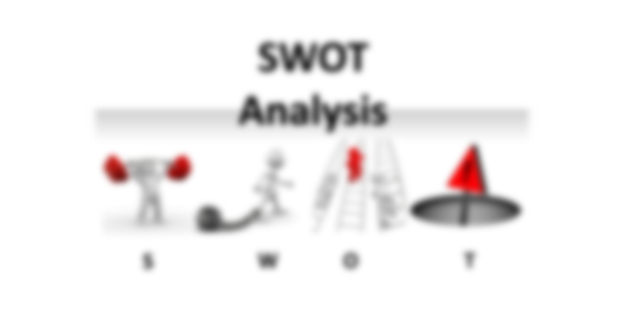
Click here to download the SWOT Analysis Template
The customer service SWOT analysis template explains how organizations can make their customer service department better. This involves examining the resources, infrastructures, and humans that make the company provide excellent service to its customers.
- Narrative SWOT Analysis Template
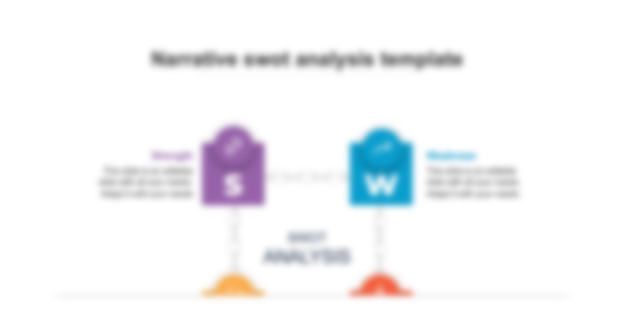
Click here to download the SWOT Analysis Template
The narrative SWOT analysis template is used for identifying and assessing internal and external strengths and weaknesses, as well as opportunities and threats, that affect current and future operations and assist in the development of strategic goals.
This template is created like a narrative, which makes it seem like you’re telling a story. It doesn’t employ shapes and diagrams in the analysis.
- Social Media SWOT Analysis Template

Click here to download the SWOT Analysis Template
The social media SWOT analysis template helps you to get a comprehensive review of your company’s social media initiatives and activities. It lets you dig deeper into your marketing approach rather than just looking at likes, shares, and other essential social media indicators.
It also enables you to discover and resolve issues while taking preventive measures to ensure that your internet marketing activities are future-proofed.
- 3D SWOT Analysis Template

Click here to download the SWOT Analysis Template
The 3D SWOT analysis template is a SWOT analysis in a three-dimensional shape. It presents the strengths, weaknesses, opportunities, and threats of a company in a detailed way that you can quickly leverage to improve yourself as an individual or a company. It allows you to better understand the value of an individual or company.
Chapter Eight: SWOT Analysis Templates for PDF
You can easily document your SWOT analysis templates in PDF format. We’ve compiled 15+ free SWOT analysis templates for PDF, which you can download, tweak, and use for your organization.
- Personal SWOT Analysis Template

Click here to download the SWOT Analysis Template
The personal SWOT analysis template helps you to achieve your career or personal life goals. It gives you much-needed insights into your personality’s strengths and weaknesses, the obstacles you face, and the opportunities that are available to you now and in the future.
For instance, if your aspiration is to be a technology company founder, this analysis gives you a detailed overview of what you have and the skills or experiences you need to achieve this. It also highlights how external factors, like the economy of your country, could affect your aspirations.
- Brand SWOT Analysis Template

Click here to download the SWOT Analysis Template
The brand SWOT analysis template allows you to uncover internal and external issues that may affect the brand’s performance. With it, you can audit your brand activity and better understand your industry.
When you understand your existing position in the marketplace, you can estimate your company’s most valuable asset, the areas where you can make improvements, the industry trends that you expect to emerge, the changes that could lead to new opportunities, and the challenges you’re up against.
- Restaurant SWOT Analysis Template
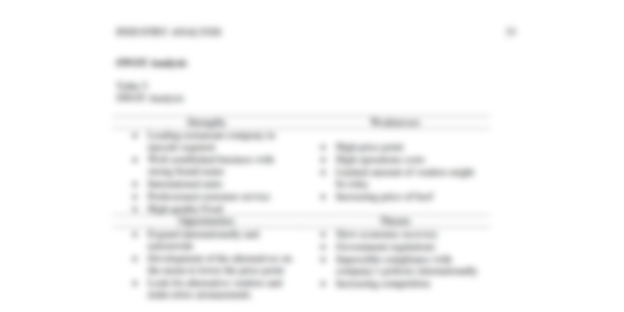
Click here to download the SWOT Analysis Template
The restaurant SWOT analysis template helps your restaurant stand the test of time and profit in the hospitality industry. For instance, your restaurant may have the nicest ambiance or provide the most delectable appetizers. That’s your business strength.
This template shows how your business can continue to profit, and overcome business challenges, be it internal or external.
- Childcare SWOT Analysis Template

Click here to download the SWOT Analysis Template
The childcare SWOT analysis template explains the factors that will determine the successful operations of your childcare business. It allows you to identify the flaws and threats associated with your business, which can be a good thing because it will encourage you to address them.
For instance, the risk of a court case can be avoided by purchasing liability insurance that covers a number of events that may arise on your engagements with children and parents.
- Healthcare SWOT Analysis Template

Click here to download the SWOT Analysis Template
The healthcare SWOT analysis template shows you the “big picture” of your hospital, hence helping you to assemble, assess, and evaluate the major influences that support or oppose your strategic goals.
- Leadership SWOT Analysis Template
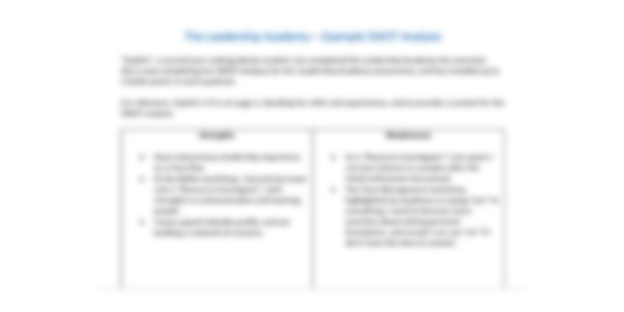
Click here to download the SWOT Analysis Template
The leadership SWOT analysis template is used by leaders to self-check their activities and implement an action plan so that they can assist others to grow since a true leader realizes that the critical foundation for success is a team’s effort.
Leaders are able to push others to stay strong so that they may also lead well from a position of strength by taking personal inventory of their interactions and the impact of the leadership.
- Competitor SWOT Analysis Template

Click here to download the SWOT Analysis Template
The competitor SWOT analysis template helps you to evaluate your business strengths, weaknesses, opportunities, and dangers that could possibly occur daily.
With this template, you’re able to broaden your scope of knowledge to see what your competitors are up to. It also creates an establishment of a competitive landscape and lets your team make strategic decisions.
- Financial SWOT Analysis Template

Click here to download the SWOT Analysis Template
A financial SWOT analysis template helps you to get a broad picture of your company’s current and future financial situation. It provides you with insights into how an organization’s finances are doing at the current time, as well as the potential occurrences that could drastically impact its finances.
It helps your company to prepare both financially and strategically by understanding what revenues and expenses to expect and how to pivot to improve your financial standings.
- Fire Department SWOT Analysis Template

Click here to download the SWOT Analysis Template
The fire department SWOT analysis template allows you to evaluate the department’s strengths, weaknesses, threats, and opportunities. With this tool, you can create a process to follow industry rules, regulations, and policies that align with you to achieve your objectives.
- Information Technology SWOT Analysis Template

Click here to download the SWOT Analysis Template
The information technology SWOT analysis template helps you to properly plan and better approach the infrastructure’s theory of constraints and execution of information technology projects.
It also helps you to understand the trade-off limits that may happen during the lifespan of an IT project due to limited resource availability and the critical need for timely project delivery.
- Nonprofit SWOT Analysis Template
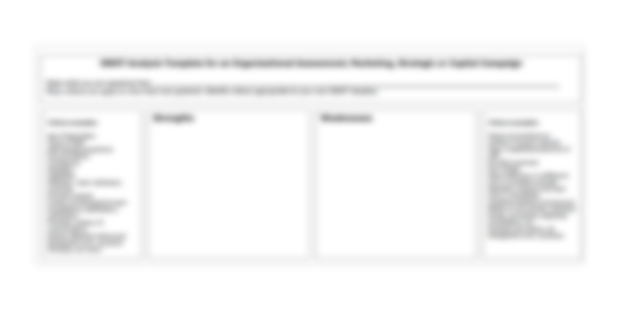
Click here to download the SWOT Analysis Template
The non-profit SWOT analysis template provides you with a simple method to delve into the details of your nonprofit’s operations and uncover the truth, allowing you to assess how effectively you’re working.
When you are able to uncover the strengths that your company has, you will realize the advantages you have over competitors, and this will give you access to the resources you need to grow your non-profit.
- Project Management SWOT Analysis Template

Click here to download the SWOT Analysis Template
The project management SWOT analysis template is a strategic planning tool that project managers use to assess the strengths and weaknesses of their projects, as well as any opportunities and threats they may face.
It serves as a contingency plan that will help you to account for the potential problems and opportunities that may develop throughout the course of your project.
- Career Change SWOT Analysis Template

Click here to download the SWOT Analysis Template
The career change SWOT analysis template helps you develop a strategic forecasting document that outlines your career from where you are at the moment to where you want to be in the future.
When you see your personal strengths, weaknesses, threats, and opportunities through the lens of this tool, you’ll better create a change in your career and redirect to activities to match your mission, vision, and outcomes in your career journey.
- Exec SWOT Analysis Template

Click here to download the SWOT Analysis Template
The SWOT analysis template for executives guides top-suite execs and managers to evaluate their firm’s environment, strengths, and weaknesses, especially when creating a new business from scratch. It also allows them to figure out the external threats and opportunities that could come to them.
With this tool, executives can also improve the strength of the company so that they can succeed at matching internal and external issues during the idea creation process.
- Consultant SWOT Analysis Template

Click here to download the SWOT Analysis Template
The consultant SWOT analysis template is a tool that business process consultants use to gain and retain their clients. This will help you to first understand yourself so that you can better specialize and position yourself for business opportunities. It also lets your clients decide whether to hire you or not. It further allows you to evaluate the market and its competitiveness on a frequent basis.
- Modern SWOT Analysis Template
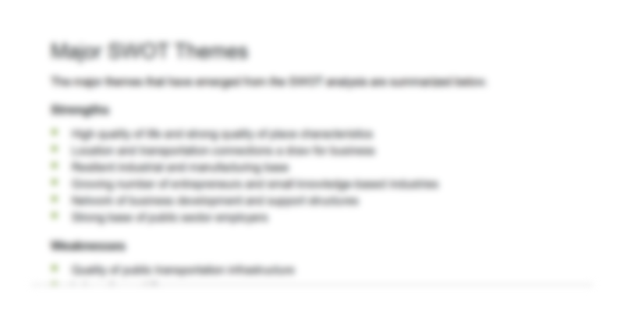
Click here to download the SWOT Analysis Template
The modern SWOT analysis template is the modernized form of a valuable management tool in strategic planning that includes trendy text placeholders and unique shapes and icons.
It helps you to display an organization’s strengths, weaknesses, opportunities, and dangers in a strategic way.
- Sample SWOT Analysis Template
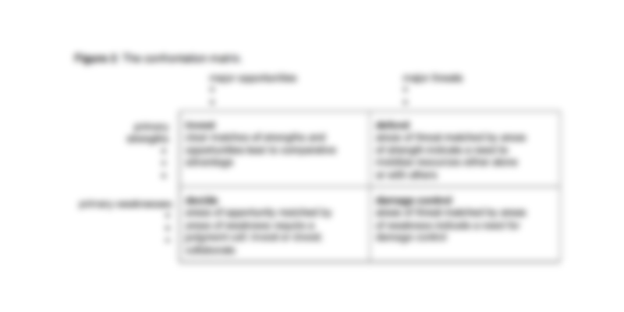
Click here to download the SWOT Analysis Template
The sample SWOT analysis template can be used to create a regular value analysis. It is not particular to any industry, individual, or organization. It’s a basic two-by-two grid that puts your top strengths, weaknesses, opportunities, and threats into an ordered list.
So, irrespective of your situation, career, or type of individual that you are, this template will be a perfect fit.
- Professional SWOT Analysis Template

Click here to download the SWOT Analysis Template
The professional SWOT analysis template is a standard professional method for evaluating an individual’s or company’s past, present, and future situation.
It gives you, your team, or any organizational executives a fresh perspective on what the company does effectively, where the company’s difficulties are, and which paths to take.
- Store SWOT Analysis Template

Click here to download the SWOT Analysis Template
The store SWOT analysis template helps you to analyze your enterprise retail department. By frequently utilizing your SWOT, you will get a comprehensive examination of the retailer’s strengths, weaknesses, opportunities, and threats in relation to significant market competitors.
This will provide you with the merchant overview as it influences the strengths and limitations and the markets, and this could be favorable or bad depending on the conditions that retailers experience on a regular basis.
- Sales SWOT Analysis Template

Click here to download the SWOT Analysis Template
The sales SWOT analysis template assists you to determine where your company stands in the market from a sales and marketing standpoint. It allows you to learn how it compares to your competitors’ products and how to use your unique selling factors to achieve market share.
It comprises guidance that you can apply to sales and marketing through customers’ preferences. These include your price point, product benefits, or customer service.
Chapter Nine: SWOT Analysis Templates Frequently Asked Questions (FAQs)

There are lots of questions that people raise when talking about SWOT analysis. In this chapter, you’ll get answers to these FAQs about SWOT analysis templates.
Why is a SWOT analysis important?
A SWOT analysis is important because it helps you get visibility into the current situation of your business. It also allows you to analyze your strengths and weaknesses, maximize every opportunity, and be alerted to possible threats. That way, you can penetrate the market to meet specific business goals while focusing on what you do well, addressing what you are lacking, and minimizing risks.
What comes after a SWOT analysis?
After performing your SWOT analysis, the next thing to do is to work on them. There is no general way of handling SWOT results that fits each and every business.
Since every business is different, the actions deduced from the SWOT exercise would definitely have distinctive features.
Weaknesses and threats that reinforce each other should be taken a closer look into.
To begin, you should aim to capitalize on opportunities that complement your strengths. Opportunities that align with your strengths may lead you to undertake a forceful expansion approach. Other strategic options may be recommended as a result of your SWOT analysis.
Also, concentrate on your weaknesses. Make a decision about which flaws should be fixed first. Other weaknesses must be acknowledged and respected until time and resources allow you to come up with a solution.
Finally, shield yourself against threats. You can do this in the following ways:
- Develop successful (win-win) connections with suppliers and customers
- Make sure your contracts with suppliers, customers, and staff are clear and reasonable
- Obtain insurance against obvious disasters
- Prepare for unexpected challenges with practical contingency plans.
What are the four dimensions of SWOT analysis?
The four dimensions of SWOT are the pillars that help you to draft out business strategy in order to achieve notable success. These include the strengths, weaknesses, opportunities, and threats.
When and where should you develop a SWOT analysis?
SWOT analysis is used in a variety of industries to assess a company’s strengths, weaknesses, opportunities, and threats. Although it is most commonly used to evaluate business ventures, it can easily be used for nearly anything that is influenced by external and internal factors.
So you can develop a SWOT analysis anytime and anywhere.
How do you use your SWOT analysis?
SWOT analysis is a necessary and strategic tool that helps you to define your team’s strengths, weaknesses, opportunities, and threats.
The strength and weakness categories are issues that exist within the company. This is where you figure out what you’re good at and what you’re not so good at. Knowing your strengths allows you to concentrate your efforts on the areas where you can make the most progress.
Outlining your weaknesses helps you to consider outsourcing or finding someone to improve your company’s overall performance. This also involves determining whether external alternatives can assist you in addressing these weaker areas.
However, for the opportunities and threats, your capacity to capitalize on these external factors will decide the long-term success of your company.
Outside of the business, there exist opportunities and threats that require you and the management team to be continually informed of what is going on. Successful companies recognize these external factors to help them shape their long- and short-term business goals.
Why should I conduct a SWOT analysis?
As long as you are a growth-minded individual, business owner, entrepreneur, or c-suite executive, conducting a SWOT analysis is a necessary action before you begin any phase in your career or task in your business.
It is an easier way to evaluate your capabilities and capacities.
Being aware of your internal strengths and weaknesses and external opportunities and threats will help you identify areas where you are performing well and where you need improvements.
What’s the difference between a SWOT and PESTEL analysis?
The main difference between a SWOT and a PESTLE analysis is that a SWOT focuses on activities you can do internally to your corporate environment, but a PESTLE analysis highlights external elements that are mostly outside your control.
When determining whether your new business idea is viable, you must conduct a SWOT and PESTLE analysis.
A SWOT and PESTLE analysis can assist you in making the best decision and weighing the benefits and drawbacks of your desired business. You can apply these to both large and small projects to identify areas of success or potential failure.
But should you use a SWOT or PESTLE analysis?
This, of course, is dependent on your industry, but there are simple ways to incorporate a PESTLE into your SWOT.
This video below walks you through the difference between a SWOT and PESTEL analysis.
What are the 3 Cs in SWOT analysis?
For businesses, the three Cs in SWOT are a company, competitors, and customers. The four grid points of SWOT analysis move beyond that theory to form the three-C model for your business.
In most managerial settings, the company’s strengths and weaknesses are grouped into one and often attached to the owners, while the adversaries would be the competitors.
Chapter Ten: Manage Your SWOT Analysis Templates Effectively Using SweetProcess

Using SweetProcess, you can manage your company’s SWOT analysis effectively. Here are some companies that have leveraged this tool for this purpose and many more.
DFK Hirn Newey is a B2B company with 30 full-time employees in the financial and professional services space. This accounting firm is made up of consultants and business advisors who help solve the varied issues related to accounting, taxation, and information technology their customers have.
One of the leaders in the organization, Paul Fiumara knew that policies and procedures would play an important role in maintaining compliance in an industry with many and varied professional obligations.
But he soon discovered that communication was a problem. To further aggravate matters, he realized and described the process of getting key information down in a written document as a “burdensome task.”
He was not deterred by the challenge at hand and attempted to implement written procedures and checklists. But this only added to the complexity, with procedures living in applications, the minds of employees, or in an instruction manual.
The biggest cost in attempting to systematize the business was having to retrain staff on new software. Paul explains he had to face a myriad of problems while trying to keep up with the latest tech:
“The staff would get disgruntled, they’d refuse to comply, we’d have to redo the work, some employees would leave and others we had to ask to let go and it just wasn’t working out.” He also said, “As leaders, we’d often have ideas about what we wanted to achieve in a day, but something would inevitably pop up with our clients and their crisis became our crisis.”
Paul knew that he wanted a cloud-based procedure manual. He did an internet search and found SweetProcess.
After evaluating it alongside administration manager Jessica, he noted that the program ticked all their boxes.
Once Paul and Jessica finished their evaluation of SweetProcess, they presented it to all the other directors in the company and they were happy with it.
Once the company started taking advantage of SweetProcess by documenting procedures on how to use various computer applications, tackling other company problems became easier.
“Documenting procedures in SweetProcess cut that anxiety down a lot, and it did from the very beginning,” Paul said.
Paul is particularly proud of two things he achieved with SweetProcess:
First, he created a notice board within the program. Within the notice board, the individual steps became the notice items he wanted his people to be aware of from week to week. With this central repository in place, his staff was no longer bombarded with messages all day long. Thanks to this procedure, they also ended up with a permanent record of changes.
Second, Paul noted that every four to five years, the company must get an independent review done for certifications in the office, which is conducted through their professional bodies. “It’s quite a big deal. If we don’t get certified, we could have our licenses removed. So, it’s important that we pass this,” shared Paul.
Wistar Group, a property management company in the B2C and B2B space and dedicated to the efficient management of maintenance and work tickets, has also seen tremendous results from using SweetProcess.
The greatest fear of Jeremy Aspen, who is the president and principal of Wistar Group, was forever being stuck as a small company, and not being able to scale best practices. He said, “Processes and procedures are what allow your company to scale.”
Jeremy knew what the company needed to move forward but was trapped in a perpetual update cycle that led to wasted time and energy. Employees weren’t even using the right versions of the procedures.
“We had written procedures, but the team wasn’t necessarily looking at the correct document. It got too complicated too quickly to be able to rely on employees finding the right information, much less using the most accurate version of the procedure documents,” he said.
He admitted further that when you’re starting out in business, you’re just trying to get your work done, so the manual control mechanism never became a priority within the company. When that failed, they turned to Microsoft Word. Unfortunately, there was no way to ensure everyone had the same documents, so this attempt at systemizing flopped too.
Jeremy was excited when Google Drive came into the picture because now he could at least write a document and put it into an environment where anyone with credentials could access it. He found this method did work a lot better, but it still didn’t get Wistar Group to the point where they could rest assured everyone was looking at the right information, much less being made aware of recent updates.
Finally, he found SweetProcess through a Google search, and their success story began. He was the only one in the company with a background in ISO-9000, and he was the sole person involved in making the buying decision. He was the only one who knew what processes and procedures could do for the company. But with SweetProcess, everyone became knowledgeable in the company.
As Jeremy explained, “In our hope to always get better and keep good, accurate processes and procedures, we’re comfortable with the vendor we’ve selected, and it turns out this vendor is enhancing their service all the time, and now it’s more a natural part of our growth.”
At Wistar Group, employees are encouraged not to follow verbal instructions and instead rely on documented procedures.
“Processes and procedures are now embedded in the DNA of the company,” Jeremy said.
For him, it’s still a win when an employee messes up and then points to a procedure and says, “Yeah, but it’s right here—it says in the procedure that this is what I’m supposed to do.” He says employees can make that mistake all day long. All he needs to do then is have the leadership team improve the procedure.
Want to see how SweetProcess works? Click here to sign up for a 14-day free trial of the software. Never worry. You won’t be asked for your credit card details before doing so.
Conclusion
The SWOT analysis templates make it easier to identify the strengths, weaknesses, opportunities, and threats that you, your company, department, product, or service have. It provides insightful tips and a clear route to take actions that improve your company.
Since companies find it difficult to consider internal characteristics first, such as strengths and flaws, these templates provide procedures of thorough company or individual examinations to generate more effective recommendations.
That said, you must know that your SWOT analysis is a work in progress. If there is any change in one of the quadrants, it’s worth examining. You may use it to make crucial choices, build or improve plans, or communicate with the rest of the firm on how to succeed in your niche.
With a tool like SweetProcess, you can document and manage your company’s SWOT analysis templates better. That way, every important team member will have access to it and know exactly what the company is doing to remain competitive in the industry.
To derive impactful ideas through your SWOT analysis, always ask yourself: “Given the state of [external factor], our capacity to [internal factor] leads to our proposal that we [recommend].”
This will help you to develop a stronger collection of clear-cut and supported suggestions moving forward.
Want to know the SWOT analysis templates to use for your company? Click here to download the templates relevant to your industry, and get ahead of thousands of businesses that build it themselves from scratch.

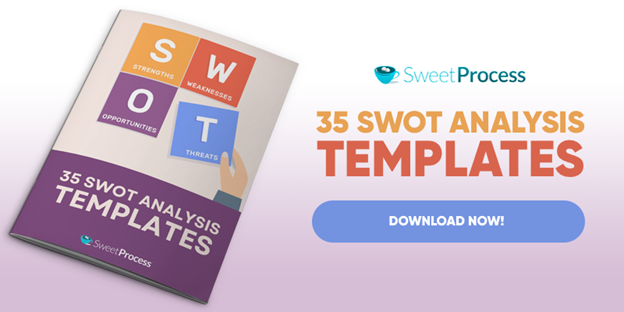




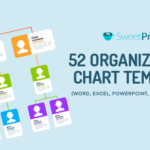



Leave a Reply